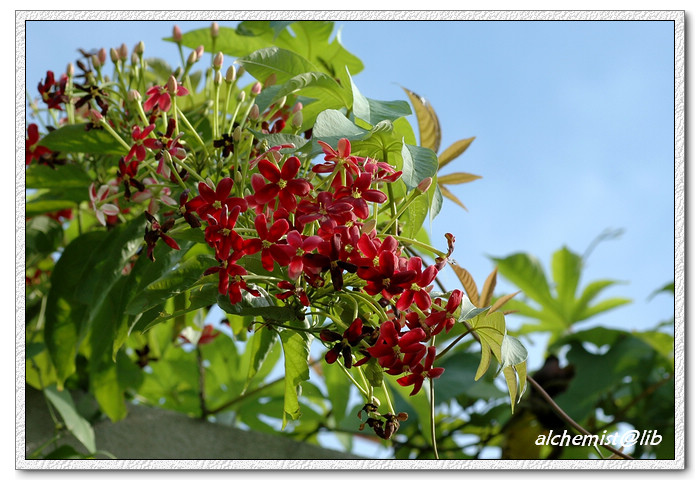- Scientific Name: Combretum indicum (L.) DeFilipps
- Ref: Useful Pl. Dominica:277. 1998
- Synonyms: Kleinia quadricolor Crantz; Mekistus sinensis Lour. ex Gomes Mach.; Quisqualis ebracteata P.Beauv.; Q. glabra Burm.f.; Q. grandiflora Miq.; Q. indica L.; Q. longiflora C.Presl; Q. loureiroi G.Don; Q. obovata Schumach. & Thonn.; Q. pierrei Gagnep.; Q. pubescens Burm.f.; Q. sinensis Lindl.; Q. spinosa Blanco; Q. villosa Roxb.
- English Common Name: Chinese honeysuckle, Rangoon creeper
- Chinese Common Name: 使君子 shǐjūn∙zǐ
- Japanese Common Name: シクンシ [使君子] shikunshi
- Family: Combretaceae
- Genus: Combretum
- Distribution: Rain forests, low woods, thickets, hedges, mountains, dry hillsides, riversides, roadsides, wasteland, also cultivated; below 1500 m. Fujian, Guangdong, Guangxi, Guizhou, Hainan, Hunan, S Jiangxi, Sichuan, Taiwan, Yunnan; cultivated in Zhejiang [Bangladesh, Cambodia, India (including Andaman Islands), Indonesia, Laos, Malaysia, Myanmar, Nepal, Pakistan, Papua New Guinea, Philippines, Singapore, Sri Lanka, Thailand, Vietnam; coastal E Africa, Indian Ocean islands, Pacific islands; introduced to other parts of tropical Africa and Central and South America; widely cultivated and often naturalized in the tropics].
- Photo: 06/18/2009, Xiamen, Fujian
Lianas to 8 m tall. Branchlets brownish yellow pubescent. Petiole 5-9 mm, without an inflated joint near base, densely brown pilose when young; leaf blade mostly oblong-elliptic or elliptic, 5-18 × 2.5-7 cm, abaxially sometimes brown pilose, adaxially glabrous except slightly brown pilose on midvein, finely white verruculose, rarely tomentose on both surfaces, base obtuse, apex acuminate to shortly caudate; lateral veins in 7 or 8 pairs. Inflorescences lax; bracts deciduous, filiform-linear to ovate, 3-12 mm, brown pilose. Flowers fragrant. Calyx tube 5-9 cm, yellow pilose; lobes deltoid, 2-3 mm, apex acute or shortly acuminate but not cuspidate. Petals opening white, later turning yellowish abaxially and reddish adaxially, obovate to oblanceolate, 10-24 × 4-10 mm, apex rounded to obtuse. Fruit red when young, greenish black or brown when ripe, fusiform or narrowly ovoid, sharply 5-ridged, 2.7-4 × 1.2-2.3 cm, glabrous, apex mucronate. Fl. Mar-Nov, fr. Jun-Nov. (Flora of China)
